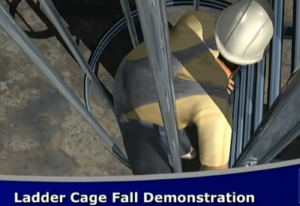Fall Protection Options for Vertical Climbing Applications
Although people tend to associate fall protection systems with rooftop applications, countless workers spend each day climbing ladders to service wind turbines, cell phone towers, and water towers just to name a few. This post focuses on OSHA requirements for fixed ladders and fall protection best practices for vertical applications.
The relevant OSHA requirements for the fixed ladder applications mentioned above include:
- 1926.1053(a)(19)
- Where the total length of a climb equals or exceeds 24 feet (7.3 m), fixed ladders shall be equipped with one of the following: 1926.1053(a)(19)(i) Ladder safety devices; or 1926.1053(a)(19)(ii) Self-retracting lifelines, and rest platforms at intervals not to exceed 150 feet (45.7 m); or 1926.1053(a)(19)(iii)
- A cage or well, and multiple ladder sections, each ladder section not to exceed 50 feet (15.2 m) in length. Ladder sections shall be offset from adjacent sections, and landing platforms shall be provided at maximum intervals of 50 feet (15.2 m).
 If you read the OSHA requirements carefully, it’s clear that a ladder alone is not OSHA compliant. The language also suggests that properly constructed cage systems offer OSHA compliance, but is this considered a best practice? From a maintenance perspective, ladder cages are expensive to fabricate/install and these systems require periodic painting and maintenance in harsh climates. From a safety perspective, ladder cages impart a false sense of safety because they do nothing to arrest falls. Long falls are common with cage systems, and in the event that the worker sustains an incapacitating blow to the head, rescue operations in the confined space are difficult. From a best practices standpoint, a vertical lifeline is often your best fall protection option for vertical climbing applications.
If you read the OSHA requirements carefully, it’s clear that a ladder alone is not OSHA compliant. The language also suggests that properly constructed cage systems offer OSHA compliance, but is this considered a best practice? From a maintenance perspective, ladder cages are expensive to fabricate/install and these systems require periodic painting and maintenance in harsh climates. From a safety perspective, ladder cages impart a false sense of safety because they do nothing to arrest falls. Long falls are common with cage systems, and in the event that the worker sustains an incapacitating blow to the head, rescue operations in the confined space are difficult. From a best practices standpoint, a vertical lifeline is often your best fall protection option for vertical climbing applications.
|
Comparison of Ladder Cages Versus Vertical Lifelines |
|
|
Ladder Cage |
Vertical Lifelines |
|
Time consuming/costly installation |
Faster and less expensive installation |
|
More material exposed to the elements means greater susceptibility to rust |
Designed to withstand harsh climates with system lifespan of 10+ years |
|
Regular painting and maintenance required |
Requires little maintenance |
|
No Fall Arrest |
Fall Arrest |
|
Difficult rescue procedure |
Safe and efficient rescue options |
The use of ladder cages for vertical climbing applications is OSHA compliant, but this solution does not provide the greatest margin of fall protection safety for workers. Conversely, OSHA does not require use of a vertical lifeline for these applications. In many instances, clients assume implementing a fall protection solution deemed a “best practice” will also be the most expensive option, but in this case, the vertical lifeline solution is actually a more cost effective alternative. Partnering with a company specializing in fall protection gives you the best opportunity to explore available options while ensuring OSHA compliance and worker safety. To learn more about vertical lifelines or to discuss your application, contact the safety experts at Diversified Fall Protection for additional information.
Schedule an assessment with Diversified Fall Protection
Contact Us to request a fall safety review

b-1.jpg?width=1368&height=1340&name=Rail%20(175)b-1.jpg)

